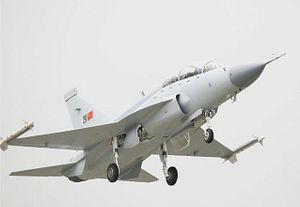A prototype of the two-seat trainer variant of the Pakistan Aeronautical Complex/Chengdu Aerospace Corporation (PAC/CAC) JF-17 Thunder combat aircraft, dubbed JF-17B, has successfully conducted a maiden flight on April 27, according to media reports. The maiden is believed to have taken place in China’s Chengdu province from a CAC airfield.
As I reported elsewhere, production of the JF-17B kicked off in April 2016. The aircraft was expected to embark upon its maiden flight by the end of that year and the Pakistan Air Force intended to induct its first JF-17B by April 2017. As of now, there are currently three JF-17B under construction, two of which will be transferred to the Pakistan Air Force in the coming months.
The aircraft is intended to enter serial production in 2018.
In comparison to the single-seat JF-17, the JF-17B variant features a dorsal fin that contains an additional fuel tank. The aircraft prototype also has a slightly larger wingspan and a marginally modified nose section to accommodate an active electronically-scanned array (AESA) radar. It also sports a larger swept-back vertical stabilizer housing a new three-axis fly-by-wire system.
Like the single-seat variant, the JF-17B features seven hard points and presumably can carry external payloads of up to 3,650 kilograms. It can be armed with air-to-air missiles, anti-ship missiles, and various guided and unguided bombs.
There is some speculation that the JF-17B will be basis for the JF-17 Block III single-seat variant of the fighter jet. (JF-17 production is split into three production blocks.) PAC/CAC have so far produced 50 Block I fighter jets and over 20 out of 50 Block II JF-17s. 14 additional Block II aircraft are expected to be produced by the end of the year.
All three aircraft variants, in addition to the JF-17B, are powered by a Russian-designed-but-Chinese-built Klimov RD-93 (a RD-33 derivative) turbofan, although there has been speculation that the PAF will procure more fuel-efficient and powerful RD-33MK turbofan jet engine, the most advanced version of the engine with a higher thrust output.
As I reported elsewhere:
The JF-17 was originally developed to to replace the PAF’s aging fleet of Dassault Mirage III/5 fighter jets by 2o20. “Pakistan is looking to replace 190 aircraft—primarily Chengdu F-7 and Dassault Mirage III/5 fighter jets—by 2020 presumably with a mixture of F-16 and JF-17 aircraft. Pakistan, however, is also allegedly in talks with Russia over the purchase of Su-35 multi-role fighters,” I reported in April (See: “China and Pakistan Air Forces Launch Joint Training Exercise”).
Pakistan has been trying to export the aircraft for some time. It is pitched as a low cost fighter for air forces in the developing world. A number of countries have purportedly expressed interest in the JF-17 fighter jet including Argentina, Bangladesh, Bulgaria, Nigeria, the Philippines, Venezuela, and Zimbabwe. Pakistan announced in 2015 that has a first international customer for the aircraft, but so far has refused to confirm the Asian country in question.
































